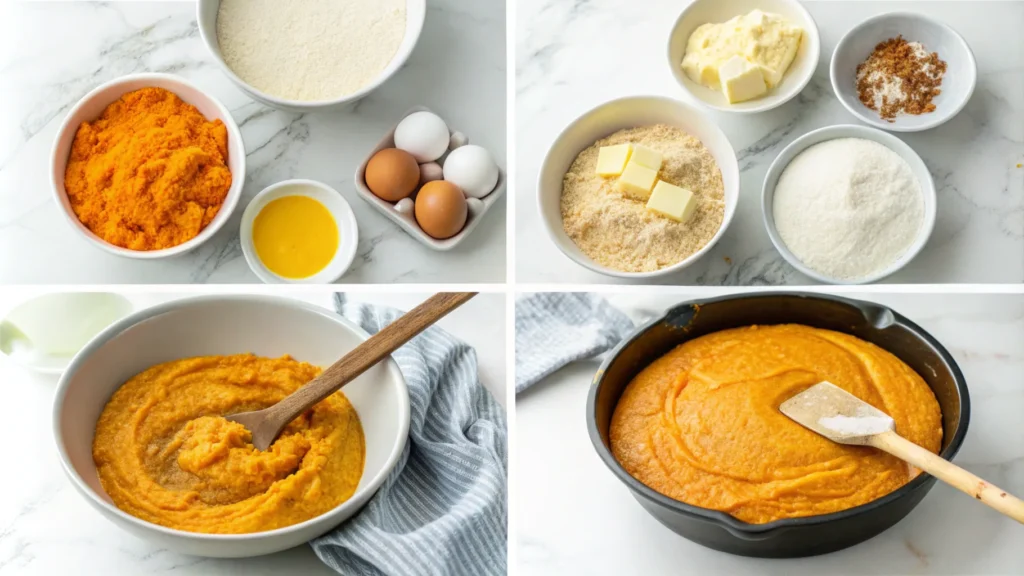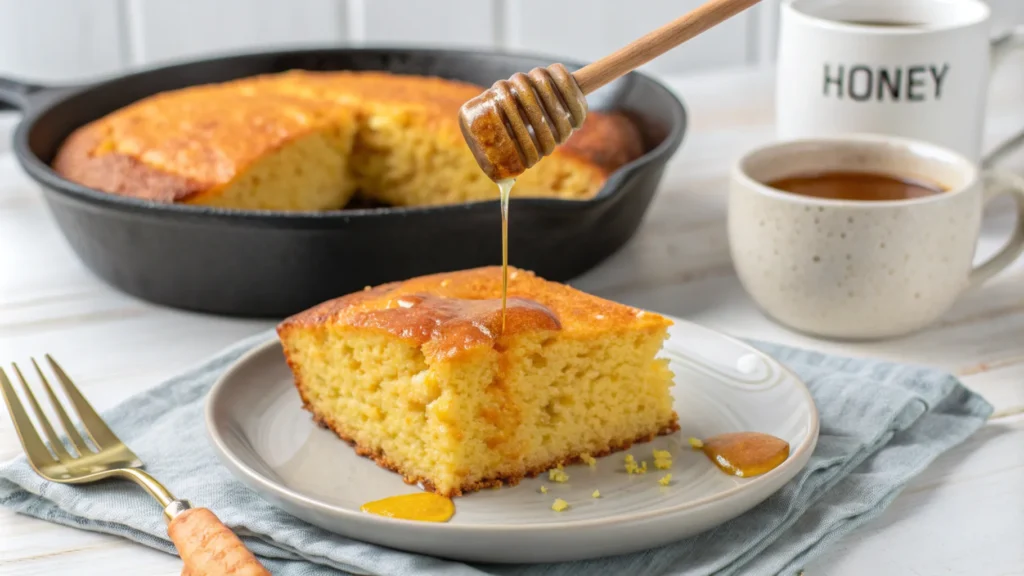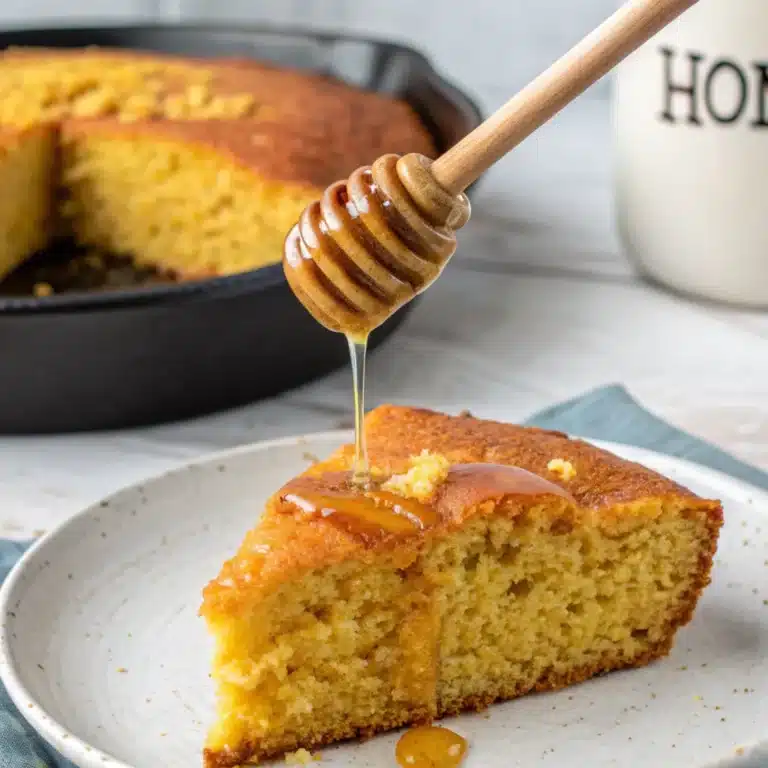Sweet potato cornbread is a delightful twist on the classic Southern staple. This dish combines the earthy sweetness of pureed sweet potatoes with the rustic texture of cornbread, making it a versatile side dish or stand-alone treat. In this article, you’ll learn everything about sweet potato cornbread: its unique characteristics, how to make it from scratch, variations to suit your dietary needs, and how to pair it with your favorite meals. Let’s dive into this warm and flavorful world!
Table of Contents
Introduction to Sweet Potato Cornbread
What Makes Sweet Potato Cornbread Unique?
Sweet potato cornbread combines the natural sweetness of sweet potatoes with the rustic charm of cornbread, creating a dish that’s both versatile and flavorful. This tender, moist bread pairs well with hearty meals like chili or stew, or can be enjoyed as a snack with a drizzle of honey. By adding spices like cinnamon or nutmeg, you can Promote its flavor profile, making it perfect for holidays or casual dinners. It’s easy to customize for dietary needs, including gluten-free or vegan versions. Whether baked fresh or reheated, sweet potato cornbread is a comforting classic you’ll want to enjoy again and again.
The Rise of Sweet Potato Variations in Traditional Southern Cuisine
In recent years, sweet potato has quickly become a favorite ingredient in Southern kitchens, Smoothly making its way into everything from pies to casseroles—and now cornbread. This versatile root vegetable, which is not only loved for its rich flavor but also for its nutritional benefits, brings a distinctive flair to many classic recipes. Moreover, sweet potato cornbread perfectly bridges the gap between savory and sweet, making it an excellent choice for pairing with hearty dishes like chili or, alternatively, enjoying as a standalone snack with a drizzle of honey. Without a doubt, it’s a dish worth trying!
Ingredients and Their Roles
The Key Ingredient: Sweet Potatoes
Sweet potatoes are the heart and soul of sweet potato cornbread. Their natural sweetness and creamy texture bring a whole new dimension to this traditional recipe. To achieve the best flavor, use fresh sweet potatoes over canned ones. Boil them until fork-tender, then puree them for a smooth consistency that mixes Smoothly into your batter.
When choosing sweet potatoes, opt for ones with vivid orange flesh, as they tend to be sweeter and richer in nutrients. They not only Improve the taste but also keep the cornbread moist and tender.
Balancing Flavors with Warm Spices
Adding warm spices like cinnamon, nutmeg, and clove to the batter not only transforms the cornbread into a cozy treat but also Improves its flavor complexity. These aromatic spices naturally complement the sweet potatoes’ inherent sweetness, creating a harmonious blend of savory and sweet flavors that’s hard to resist. Furthermore, just a pinch of clove or nutmeg can significantly impact the taste, so it’s wise to use them sparingly to maintain balance and avoid overpowering the dish.
However, for those who enjoy a milder flavor, reducing the spices is always an option. On the other hand, if bold and robust flavors are your preference, adding a touch more cinnamon can beautifully Promote the cornbread’s overall profile, making it even more indulgent.
Cornmeal and Flour Ratio: Achieving the Perfect Crumb
The balance between cornmeal and flour is essential for getting that classic cornbread texture. Cornmeal gives the bread its signature grit and rustic charm, while flour adds softness. Sweet potato cornbread often has slightly more cornmeal than flour, which helps maintain its hearty feel without becoming too cake-like.
For an extra rustic texture, you can increase the cornmeal. Conversely, reducing it will make the cornbread lighter and fluffier—perfect for those who prefer a softer crumb.
How to Make Sweet Potato Cornbread
Preparing the Sweet Potato Puree
The foundation of great sweet potato cornbread starts with smooth and creamy sweet potato puree. To prepare:
- Begin by boiling whole sweet potatoes with their skins on until they’re fork-tender. This keeps them moist and locks in nutrients.
- Once cooled, peel off the skins—they should slip right off—and mash or blend the flesh until it’s smooth and lump-free. A food processor works best for achieving a silky consistency.
- Measure one cup of the puree for the recipe to Secure the right balance of flavor and moisture.
Mixing the Wet and Dry Ingredients
The trick to making the perfect batter lies in carefully combining the wet and dry ingredients to maintain the ideal texture. To begin, whisk together the dry components, such as cornmeal, flour, sugar, baking powder, warm spices, and a pinch of salt. This step Secures an even distribution of flavors and helps prevent lumps. Meanwhile, in a separate bowl, mix the wet ingredients, which include sweet potato puree, melted butter, eggs, vanilla, and buttermilk. By preparing each mixture separately, you set the stage for a smooth, lump-free batter when combining them later. This approach guarantees deliciously tender sweet potato cornbread!
When it’s time to combine them, pour the wet mixture into the dry ingredients slowly, stirring just until combined. Overmixing can make the cornbread dense and tough, so stop as soon as everything is incorporated.

Baking and Achieving the Perfect Golden Crust
Preheat your oven to 400°F and grease your baking dish or cast-iron skillet. Pour the batter evenly into the pan, smoothing out the top with a spatula. For an even bake, place it on the middle rack.
Bake the cornbread for about 20 minutes, then tent it with aluminum foil to prevent over-browning. Continue baking for another 20 minutes or until a toothpick inserted into the center comes out clean. The result? A golden, perfectly crusted sweet potato cornbread with a moist, tender crumb.
Variations and Creative Twists
Making It Gluten-Free or Vegan
Sweet potato cornbread can easily be adapted to meet dietary needs. To make it gluten-free, substitute the all-purpose flour with a gluten-free baking mix or almond flour. Secure the cornmeal is labeled gluten-free to avoid cross-contamination.
For a vegan version, replace the eggs with flaxseed meal or unsweetened applesauce, and use almond milk instead of buttermilk. A touch of apple cider vinegar can help mimic the tanginess of buttermilk.
Adding Unique Toppings or Mix-Ins
Promote your sweet potato cornbread with creative additions. Mix in chopped pecans or walnuts for added crunch, or sprinkle shredded cheddar cheese for a savory twist. Dried cranberries or raisins can Improve its natural sweetness, making it perfect for brunch or dessert.
A brown sugar glaze or drizzle of honey butter can also transform this dish into a sweet centerpiece. These toppings add a glossy finish and an extra layer of flavor, perfect for special occasions.
For more delicious recipe ideas, check out our guide to making sweet and savory dishes on Masterly Recipes.
Pairing Sweet Potato Cornbread with Meals
Best Savory Pairings
Sweet potato cornbread shines alongside hearty, savory meals. Pair it with a bowl of spicy chili, smoky collard greens, or rich stews for a classic Southern combination. Its subtle sweetness complements the bold flavors of barbecue chicken or grilled ribs, creating a balanced plate.
For a lighter option, serve it with roasted vegetables or a fresh salad. This versatility makes sweet potato cornbread a go-to side dish for family dinners and potlucks alike.
Using Cornbread as a Sweet Treat
This dish isn’t just a side—it’s also a delightful snack or dessert. Warm slices can be topped with whipped cream or served with a scoop of vanilla ice cream. A sprinkle of cinnamon sugar takes it from simple to indulgent in no time.
Whether served as a savory side or a sweet finale, sweet potato cornbread offers endless possibilities to satisfy any craving.
Storage and Reheating Tips
Refrigeration and Freezing Guidelines
Proper storage Secures your sweet potato cornbread stays fresh and flavorful. If you plan to eat it within a few days, let it cool completely before wrapping it tightly in plastic wrap or aluminum foil. Store it in the refrigerator for up to three days to maintain its moisture.
For longer storage, freezing is the way to go. Wrap individual slices in plastic wrap and place them in a freezer-safe bag or airtight container. This method prevents freezer burn and makes reheating more convenient. Frozen cornbread can last up to three months while retaining its taste and texture.
Best Practices for Reheating While Preserving Moisture
Reheating sweet potato cornbread without drying it out can be tricky, but it’s easy with the right approach. For a quick option, use the microwave—just wrap a slice in a damp paper towel and heat for 15-20 seconds. For a crispier texture, warm it in the oven at 300°F for 10-15 minutes.
If you’ve frozen the cornbread, let it thaw at room temperature before reheating. This Secures even heating and keeps the bread soft and delicious.
Common Questions Answered
Can Sweet Potato Cornbread Be Made in a Cast-Iron Skillet?
Absolutely! A cast-iron skillet adds a rustic touch and gives the cornbread a beautifully crisp edge. Be sure to preheat the skillet in the oven before pouring in the batter, as this helps the bread cook evenly and develop its golden crust.
How to Adjust Sweetness Levels?
If you prefer less sweetness, reduce the amount of granulated sugar or skip the brown sugar glaze. On the other hand, adding a touch of honey or maple syrup can Improve the natural sweetness of the sweet potatoes without overpowering the flavor.
Using Canned Sweet Potatoes or Pumpkin Substitutes
Canned sweet potatoes are a convenient option, but Secure they’re plain and not pre-sweetened or spiced. For a fun twist, you can swap sweet potatoes for canned pumpkin. The flavors are similar, but pumpkin lends a slightly earthier taste.
Can I Make It Without Eggs or Dairy?
Yes, you can! Replace eggs with a flaxseed meal or mashed bananas, and swap buttermilk with almond milk and a splash of apple cider vinegar. These substitutions keep the cornbread moist and vegan-friendly without sacrificing flavor.
FAQs
What is the Best Way to Make Sweet Potato Puree for Cornbread?
The best way to prepare sweet potato puree is by boiling whole sweet potatoes with their skins on until they’re fork-tender. After cooling, peel the skin off and mash or blend the flesh until smooth. A creamy puree Secures your cornbread has the perfect texture and flavor.
Can I Prepare Sweet Potato Cornbread in Advance?
Yes, sweet potato cornbread can be made ahead of time. Bake it a day in advance, let it cool, and wrap it tightly in plastic wrap or foil. Store it in the refrigerator or freeze for longer storage. Reheat it before serving to bring back its warm, fresh-baked taste.
What are the Common Mistakes to Avoid When Baking Sweet Potato Cornbread?
- Overmixing the batter: This can result in dense, tough cornbread. Mix just until combined.
- Skipping the glaze: The brown sugar glaze adds a delightful sweetness and moisture—don’t miss out!
- Not preheating the oven or pan: Starting with a hot oven Secures an even bake and a crisp crust.

Conclusion and Final Tips
Why Sweet Potato Cornbread is a Must-Try Dish
Sweet potato cornbread isn’t just another twist on a classic recipe—it’s a dish that brings warmth, flavor, and versatility to the table. Whether you’re serving it as a side for a hearty meal or enjoying it as a sweet snack, this recipe never fails to delight. Its combination of earthy sweetness, warm spices, and a tender crumb makes it stand out from traditional cornbread.
Moreover, the recipe is highly adaptable, making it easy to suit various dietary preferences or experiment with creative twists. From its rustic charm to its rich flavors, sweet potato cornbread has something for everyone.
Encouraging Experimentation in the Kitchen
Don’t be afraid to personalize your sweet potato cornbread! Try adding different spices, nuts, or dried fruits to create unique variations. Experimenting with ingredients like honey glaze or even chocolate chips can add new dimensions to this beloved dish. With each batch, you’ll find new ways to enjoy this comforting classic.
For more tips and recipes to complement your sweet potato cornbread, visit Masterly Recipes.

